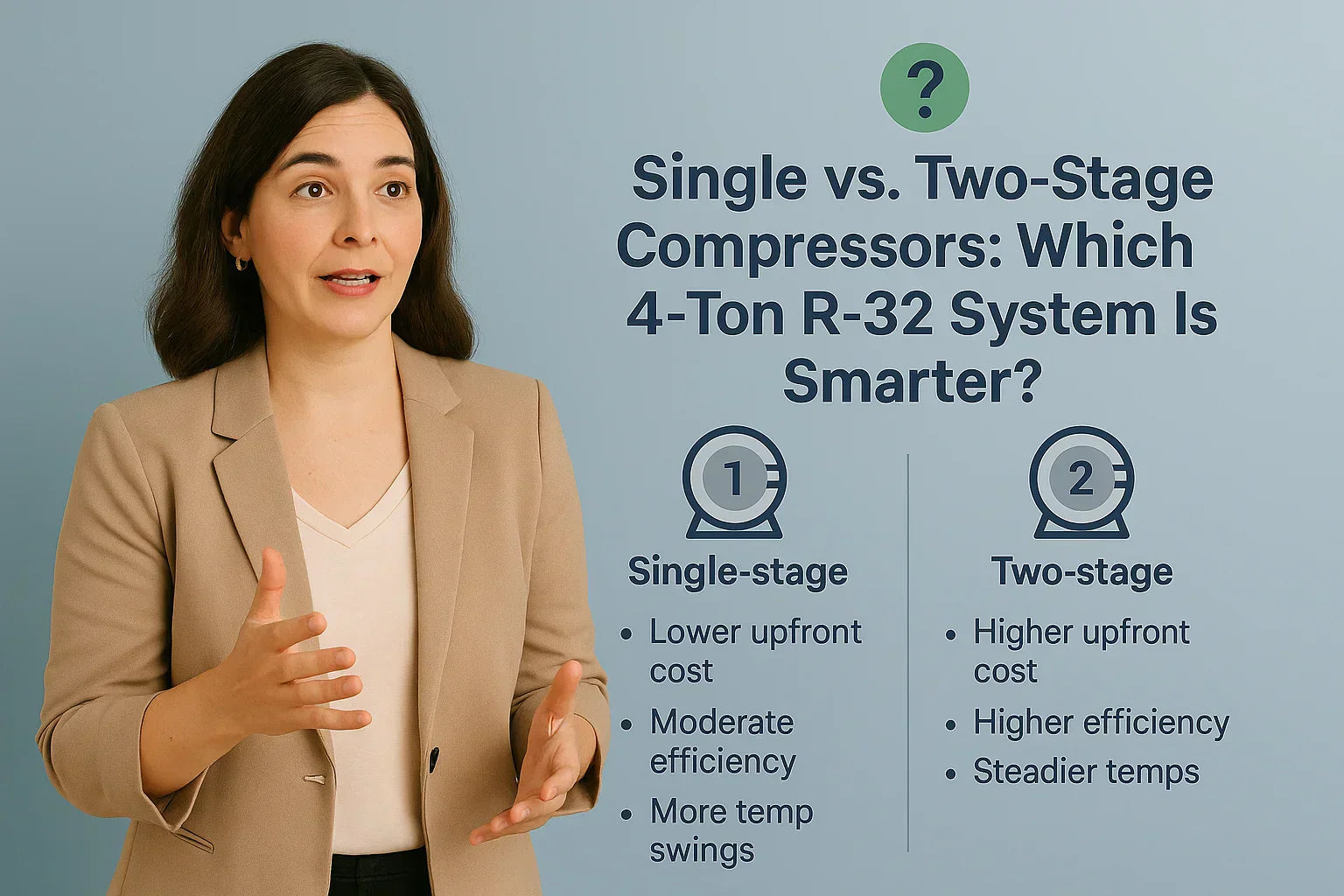If you’re in the market for a 4-ton R-32 air conditioner, there’s one major decision that will affect your home’s comfort, energy efficiency, and long-term savings: Should you go with a single-stage or two-stage compressor?
While both options can cool a home of 2,000–2,500 square feet, the way they operate is very different. And if you’re someone like Savvy—a homeowner who cares about efficiency, noise, and year-round performance—this decision is a big deal.
In this guide, we’ll walk you through what compressors do, the pros and cons of each type, and how to decide what’s best for your specific needs and climate.
🔧 What Does a Compressor Do in Your R-32 AC System?
The compressor is the heart of your AC. It pressurizes the refrigerant (R-32 in this case), circulates it through the coils, and moves heat from inside your home to the outdoors.
-
Single-stage compressors operate at 100% when on and 0% when off.
-
Two-stage compressors can run at a lower speed (typically around 65-70%) and ramp up only when needed.
This impacts not just how cool your home feels, but how efficiently and quietly your system operates.
✊ Single-Stage Compressor: Simple, Reliable, Budget-Friendly
A single-stage compressor is the most common type in traditional HVAC systems. It’s known for:
-
Lower upfront cost
-
Fewer moving parts (less complexity)
-
Quick on/off cycles
But these benefits come with trade-offs:
-
More temperature swings
-
Louder operation (due to full-speed cycling)
-
Poorer humidity control, especially in hot, humid climates
Ideal for: Smaller homes, cooler climates, or homeowners on a strict budget.
⏱️ Two-Stage Compressor: Smarter, Smoother, More Efficient
A two-stage compressor operates at two capacity levels:
-
Low stage (~65-70%) for regular cooling
-
High stage (100%) for peak demand (hot afternoons)
Benefits of two-stage compressors include:
-
✔️ More consistent indoor temperatures
-
✔️ Quieter operation (less frequent on/off)
-
✔️ Better humidity control
-
✔️ Reduced energy use due to longer, lower-capacity cycles
Ideal for: Larger homes, multi-story layouts, or regions with long summers and high humidity.
📊 Head-to-Head Comparison: Single vs. Two-Stage Compressors
| Feature | Single-Stage | Two-Stage |
|---|---|---|
| Cost | Lower upfront | Higher upfront (~$800-$1,500 more) |
| SEER2 Rating | Lower (13.4–14.3 typical) | Higher (up to 16–17+) |
| Comfort | Noticeable temp swings | Steady temps |
| Noise | Louder starts/stops | Quieter operation |
| Humidity Control | Limited | Excellent |
| Lifespan | Solid | Often longer (fewer hard starts) |
🌞 Savvy’s Experience: From Single to Two-Stage
Savvy had the chance to compare both systems in real-world settings:
-
Her old 3.5-ton single-stage system was loud and had major hot/cold zones upstairs.
-
Her new 4-ton two-stage R-32 system has:
-
SEER2 15.2
-
Zoned airflow
-
Noticeably quieter cooling
-
Results After One Year:
-
Energy savings: 17% lower summer bills
-
Noise: Nearly silent operation on low stage
-
Humidity: Indoor RH dropped from 60% to 45%
"The difference is night and day. The two-stage system runs longer but cooler, and my house feels balanced." —Savvy
💳 Cost Considerations: Worth the Upgrade?
| Item | Single-Stage 4-Ton R-32 | Two-Stage 4-Ton R-32 |
| Equipment Cost | $2,800–$3,500 | $3,800–$5,000 |
| Installation | $2,000–$3,000 | $2,200–$3,200 |
| Total | ~$5,800 | ~$7,200 |
Lifetime Payoff:
-
Energy savings over 15 years: $1,800–$2,500
-
Fewer repairs due to smoother cycling
-
Possible tax credits (check DSIREUSA.org)
🏡 Who Benefits Most from Two-Stage Compressors?
Go Two-Stage If You Have:
-
A two-story or multi-zone home
-
Long cooling seasons (e.g., South, Southwest, Southeast U.S.)
-
High humidity
-
Rooms with large window exposure
-
A desire for premium comfort and energy savings
📲 What to Look for When Shopping R-32 Systems
Not all R-32 systems are created equal. Look for:
-
SEER2 rating above 15
-
Compressor type listed as "two-stage" or "multi-stage"
-
Compatible air handler (variable-speed if possible)
-
Smart thermostat support for staging control
Recommended brands with two-stage R-32 models:
-
Goodman
-
Daikin
-
MRCOOL
-
Bosch
✅ Final Verdict: Which Is Smarter?
If your priority is lowest upfront cost and you live in a moderate climate, a single-stage compressor may be enough.
But if you want:
-
Better humidity control
-
Smoother temperature regulation
-
Quieter operation
-
Long-term efficiency
...then a two-stage R-32 system is the smarter investment.
"Savvy was glad she chose the quieter, smoother, more futureproof option."
🚀 Next Steps for Homeowners
-
Get a Manual J load calculation to confirm tonnage
-
Ask HVAC contractors for two-stage R-32 quotes
-
Compare SEER2 ratings and compressor types side by side
-
Check rebates via DSIREUSA
🔍 External Resources & Verified Links
Choosing the right compressor isn't just about BTUs. It's about balancing comfort, savings, and smarter performance—and the two-stage R-32 system delivers on all three.
In the next topic we will know more about: What Is the Price of a 4-Ton R-32 AC System? Practical Budgeting Advice







